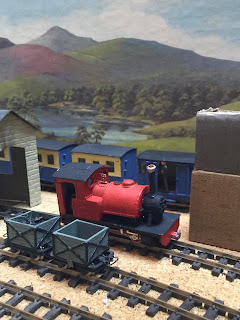 |
| Fist Basil Set |
As the month rolls into April there is another set of jobs to get done in the garden, and with the sun coming out and it feeling incredibly like spring has sprung I could not wait to get back out there. With the recent Covid-19 outbreak and the lockdown measures in place, a lot of people have been turning to their gardens as a source of comfort and something to do. I am no exception there, I feel that having something to care for and something to think about really does take my mind off what has been happening in this world around us.
It is important to note here that going out to buy gardening things is not classed as an essential trip, people should not be encouraged to go and make those extra journeys, putting themselves and others at risk. That said a few of the things I have done this past month I've done using what I had to hand, and no trips have been made to get supplies. I also know that some supermarkets are selling things like plants and bags of compost, so you can kill two birds with one stone if you really want to get your hands dirty and pick those up on your weekly essentials shop.
Last time I shared the garden with you all I had just planted the first sets of basil, spring onions and spinach. Those three sets are growing well, and three weeks after the first lot, I've planted a second sowing of all three. The Spinach moved from the sunny spot by the back door, to the windowsill in the kitchen where it has been quite happy, and hopefully soon will be ready to provide leaves.
 |
| Kitchen Windowsill Spinach |
 |
| Thinned Out Spring Onions |
The spring onions have shot up, and finally been thinned out. I only really thought later on that I remembered reading something about them needing their own space. They had grown like anything incredibly quickly and then stalled. So I got around to thinning them out to about an inch apart. I was a little torn as to what to do with the little seedlings, do I try and replant them in their own space? I was also curious as to what they were like at this early stage, so I tried one. It was actually quite onion-y so I decided to wash this little handful and had them chopped up on top of my salmon that night for tea. I was actually really quite pleased that I had managed to eat something that I had grown for the first time ever!

The basil was a slow grower, it took forever for it to pop out of the top of its pot, and I will admit it did almost lose heart in it, but a little more patience saw it through. The little plant is growing well, and when it is big enough it will probably move into the kitchen to be with its spinach friend on the windowsill.
In my offshift three weeks after I had first planted the seeds, I set about planting another set of each. This did also happen to be early April and I tackled my garden jobs list as well. I planted another two sets of spring onions. The first set was going into the garden, and is the first thing that I have actually planted outside, and I am pretty excited. I did however plant another set indoors just in case. I marked the area where I had planted them with some twine and a few sticks I found in the garden, for an easy reference for when I come to water them and to just check on them.
I also started off my carrots, these I decided to plant in a pot on the patio. This will hopefully mean that they won't come across some of the other problems they could in the ground. I'm a little worried about my carrots though, I know that April is a little early for them and not having any access to things like fleece to keep them covered is something to think about. I suppose with them being in a pot, if things get really bad outside I can just bring them inside.

I did have to wait another week for my leek seeds to arrive, which I was too late in getting at the garden centre, so had to order online. With the lockdown at the moment a lot of online businesses are working harder then ever so are taking longer to ship orders. I ordered my leeks from Suttons Seeds online and they took just over a week to get to me, which was good. They got planted in a little pot and are now sat by the back door with the other veggies, and hopefully will start to grow. They are being started "on the windowsill" for now and I think I will plan to plant them out in June time.
The second sets of spinach and basil pulled the short straw really, and I didn't have many spare pots for them, so I improvised. The spinach got planted in the bottom half of a milk bottle, and the basil in a marmite jar. I'm being a little mindful about how much I water these two, as the makeshift pots they are in do not have any drainage holes in the bottom, so have a larger chance of becoming waterlogged. But despite that, both the pots have started to germinate and I've got little bits of green poking out of the tops of both of them.

One thing that wasn't on my garden plan, was a little experiment I decided to try out. I was cutting up a red bell pepper when I was making my tea one night, and on a whim decided to save the seeds. I wanted to see if I could grow them. Reading up on how to grow pepper seeds, it mentioned the need to keep them in a propagator at a temperature of around 21 degrees (I'm paraphrasing here, don't take my advice! :P ). With us being in a lockdown, I cannot go out an purchase a snazzy propagator, and the seeds needed planting out pretty soonish. So I got my thinking head on and made a propagator out of an old milk bottle (2 pint), a scrap of cotton fabric and a sandwich bag.

I cut the milk bottle in half and cut most of the handle off, leaving a little bit of it. I then put some water in the bottom half of the bottle, up to the little line. Then cut a slot in the lid of the bottle. I threaded one end of my fabric scrap through the lid a little way. This fabric scrap is going to act like a moisture wick. I then screwed the lid back on the milk bottle and put the top half upside down in the bottom half, with the little bit of handle sticking out over the top to stop it from sliding all the way down to the bottom. The fabric should sit in the water at the bottom and come up through the lid into the top half.
I filled the top half with compost and sowed my pepper seeds. I watered it then, and put the sandwich bag over the top, tied it in place with a piece of yarn I had lying around and placed it on my spare room windowsill.

There was a lot of condensation on the inside of that bag as the weeks went on, but without having to touch it at all. two and a half weeks later I'm looking at a couple of green leaves sticking out the top looking happy. So now that gamble has taken off I need to read up on what to do next! I'm thinking I will keep these plants in a pot other than planting them outside, as they seem to need a fair amount of greenhouse time and hardening off before they can really brave the british weather. We will see what the next few weeks will bring I suppose.
If you really are curious as to how my seed propagator went together, then have a look at the pictures I've posted here, and maybe they'll explain a little bit better than I have with words.

The last unexpected garden happening, happened the most recently, when I decided that the three aloe plants that I had upstairs on the bedroom window had failed. They were three of five babies I had taken out of the mother plants pot. Whilst the other two had thrived these had turned brown, and I didn't know what I had done to them. They didn't seem to respond at all to me giving them more or less light or even varying amounts of water. I thought they had properly died, so I went outside to take them out of their pots and put them in the compost heap, but taking them out of their pots I realised that two of them had developed quite a large route system, and it seemed a shame to not try and give them a second chance. So that's what I did.
I planted the three of them out in the flower/veggie bed in the garden. They went in a section of the bed that I didn't really know what I was going to do with. We will see what comes of them now, as they aren't so reliant on me to feed them right!
That is all I have to say for this monthly round up of the garden. I really hope you are enjoying the blog, as well as the weekly updates from me are happening on both a Wednesday and a Sunday now. My plan is to release these Grow posts just as and when I get around to writing them so I don't have to try and squeeze them in and around all the other making.
So, happy making, happy gardening, and keep safe. I will see you all again really soon!
L xx
 Big wheels have been turning and Tina my spinning wheel has been busy, and I have finally spun my last braid of Pixel Atlantis fibre. This braid was a 100% BFL squishy loveliness in the Hummingbird colourway. I absolutely love the green colour it has come out with and it will hopefully be going with the other braid of Pixel Atlantis fibre I have already spun to make something exciting.
Big wheels have been turning and Tina my spinning wheel has been busy, and I have finally spun my last braid of Pixel Atlantis fibre. This braid was a 100% BFL squishy loveliness in the Hummingbird colourway. I absolutely love the green colour it has come out with and it will hopefully be going with the other braid of Pixel Atlantis fibre I have already spun to make something exciting.




































